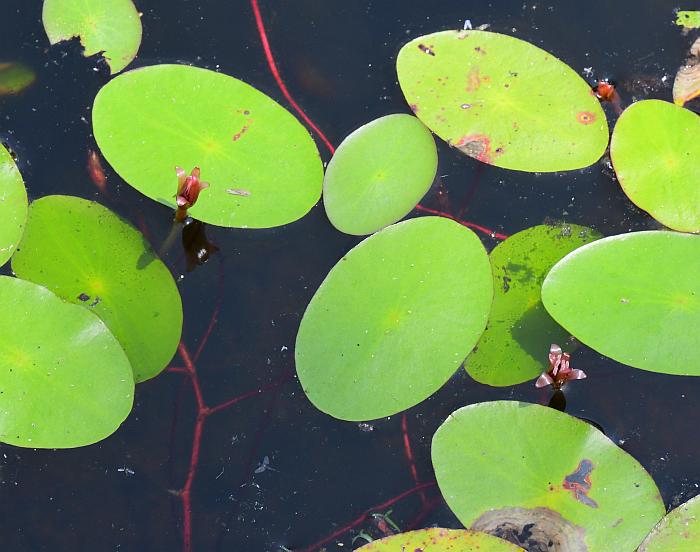Brasenia schreberi J.F. Gmel.
Water Shield, Snot Plant

Native
CC = 2
CW = -5
MOC = 28
© SRTurner
Brasenia schreberi J.F. Gmel.Water Shield, Snot Plant | |
 |
Native CC = 2 CW = -5 MOC = 28 |
© SRTurner |
|
Family - Cabombaceae Habit - Aquatic, perennial, rhizomatous. Stems - Aquatic slender stolons, potentially to 2 m or more, potentially rooting at nodes, usually submerged but sometimes floating to surface, appearing glabrous, submerged portions thickly coated with mucilage. Leaves - Alternate, monomorphic, peltate, long-petiolate, entire. Petioles and underside of leaf blades heavily mucilaginous and reddish-purple below. Petioles to 30 cm or more. Blades elliptic, to 14 cm long, 8 cm broad, glabrous and green above, reddish-purple below.
Inflorescence - Single axillary flowers on long red peduncles. Flowers stalks erect at flowering, holding flowers 5-10 cm above water surface, bending to become submerged at fruiting.
Flowers - Perianth curled outward and downward at flowering, later becoming erect and more or less enfolding the developing fruits. Sepals 3 or less commonly 4, 13-15 mm long, strap-shaped, green on the outer surface, reddish purple to maroon on the inner surface. Petals 3 or less commonly 4, slightly longer and narrower than the sepals, strap-shaped, reddish purple to maroon, glabrous. Stamens 18-36 (rarely more), erect. Filaments to 1.2 cm long, pink to purple near apex, glabrous. Anthers deep purple, 3.1 mm long. Pistils 4-18, the ovaries 5 mm long, pink, glabrous or pubescent at apex, unilocular, ovules 1-4 per locule. Style 5 mm long, deep purple at apex, with a linear stigmatic region along a side toward the tip. Placentation parietal.
Fruits - Achenelike, 6-10 mm long, club-shaped to peanut-shaped, tapered to the persistent style, maturing submerged. Seeds 2.5-4.0 mm long, oblong to oblong-ovate in outline, the surface finely pebbled, grayish brown to yellowish brown. Flowering - May - September. Habitat - Aquatic in ponds, lakes, sloughs and swamps. Origin - Native to the U.S., Central America, Asia, Australia, Africa. Lookalikes - Vegetatively resembles species of Potamogeton. Other info. - This plant occurs in widely scattered locations in Missouri, predominantly but not exclusively in the southern and eastern parts of the state. Its wider distribution includes both western and eastern states of the continental U.S., though it is missing from some mountain and southwestern states. Distributional data suggest that it is not particularly common, though it is probably undercollected due to the general inconvenience of gathering aquatic specimens. It is also difficult to prepare specimens, as the adhesive properties of the mucilage effectively glue plants to the blotters used for pressing. The species is easy to identify in the field by virtue of its peltate leaves and the thickly mucilaginous coating on submerged parts. This latter characteristic renders the plants exceedingly slippery and difficult to handle, and earns it the nickname "snot plant." Photographs taken at the Irish Wilderness, Mark Twain National Forest, Oregon County, MO., 7-15-00 (DETenaglia); also at Duck Creek Conservation Area, 8-12-2015, 8-17-2021 and 6-16-2023 (SRTurner). |